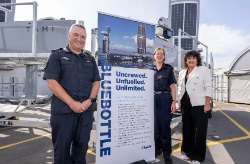Native Frog Facility To OPen At Auckland Zoo
Zoo's new frog facility a leap forward for native frog conservation
A dedicated facility at Auckland Zoo to breed one of New Zealand's most endangered native frogs is to be opened by Conservation Minister Chris Carter this afternoon.
The Carter Holt Harvey Native Frog Research Centre, a joint conservation project of Auckland Zoo, the Department of Conservation (DOC), and Carter Holt Harvey will mainly focus on breeding, researching and advocating for Archey's frog.
The smallest of New Zealand's four remaining endemic frogs (all of which are acutely threatened), Archey's frog grows to just 37mm in length, and belongs to the ancient amphibian genus Leiopelma, found nowhere else in the world. Along with Hamilton's frog, Archey's is classified as "nationally critical" - the highest DOC threat category.
“The captive breeding programme is crucial to safeguarding the long-term future of this unique native animal,” says Mr Carter. “Auckland Zoo, Carter Holt Harvey and the Department of Conservation are to be commended for their groundbreaking work in Archey’s frog conservation.”
A disease caused by chytrid fungus, first discovered in New Zealand in 1999 in Canterbury, has since been identified from dead Archey's frogs in both areas where the frog is found – the Coromandel and Whareorino Forest west of Te Kuiti. Along with introduced predators and habitat loss, chytrid fungus remains the biggest threat to the frog, and has already caused a dramatic decline in the species in the past few years. In Australia, for example, frog diseases like that caused by chytrid have been responsible for frog species being lost at a rate of two per year.
The state-of-the-art Auckland Zoo facility, which replicates the Archey's moist, misty, cool, high altitude habitat, was designed in collaboration with DOC's National Frog Recovery Group, Carter Holt Harvey, Auckland Zoo, and other similar institutions in Australasia. Even the decking surrounding the building has been isolated from the main structure, as Archey's frog feels the slightest vibration through its sensitive feet.
The zoo expects to receive its first frogs within the next couple of months.
A quarantine facility that will only be accessed by the zoo's Native Fauna team, the Carter Holt Harvey Native Frog Research Centre is an exhibit for visitors to walk around and look into from the outside, rather than enter. Signage plays a key role, and visitors can also watch a DOC video on native frogs, and, once the frogs arrive, will be able to look through and observe staff working with them, and learn about how they can assist the programme.
"Zoos have come a long way in recent years, and it’s exciting for us to reach a point where our expertise in captive rearing and our role in conservation is now recognised, and our participation required," says Auckland Zoo Director Glen Holland.
"We're delighted, that increasingly, we're being invited to be part of projects such as this, and are able to grow partnerships with DOC and key sponsors such as Carter Holt Harvey."
Captive breeding and observational research is seen as an essential part of native frog conservation – to boost natural population numbers, and to establish new populations at safe sites, both on the mainland and on off-shore islands.
"These frogs are ancient, exquisite creatures that we absolutely must not lose," says Auckland Zoo Native Fauna Team Leader Andrew Nelson, who will oversee the management of the frog facility.
“The great thing is that the facility is going to provide a safe haven for Archey’s frogs and provide an invaluable opportunity to increase our understanding of the biology and captive management of native frogs generally, which will in turn assist with management of them in the wild."
“Information gained here will also contribute to both the national and international work being carried out on frog conservation,” says Mr Nelson.
Because of Archey’s frog’s long life expectancy (30+years) and its low breeding output, populations in the wild increase very slowly – even when additional pressures like predation and disease can be minimised.
"If we can increase the survival rate of young frogs in captivity, we can then boost wild populations to the extent that will allow them to be resilient against other diseases," says National Frog Recovery Group Leader Avi Holzapfel.


 Gordon Campbell: On The Left’s Electability Crisis, And The Abundance Ecotopia
Gordon Campbell: On The Left’s Electability Crisis, And The Abundance Ecotopia NZ Government: Stay Safe On Our Roads This Easter
NZ Government: Stay Safe On Our Roads This Easter YWCA: Global Push Back Against Gender Equality A Growing Crisis In Aotearoa
YWCA: Global Push Back Against Gender Equality A Growing Crisis In Aotearoa Te Pāti Māori: Ngarewa-Packer - Fast-Tracking Seabed Mining Ignores Māori Opposition And Environmental Precedent
Te Pāti Māori: Ngarewa-Packer - Fast-Tracking Seabed Mining Ignores Māori Opposition And Environmental Precedent New Zealand Defence Force: Defence And Customs Strengthen Maritime Security With Uncrewed Surface Vessels
New Zealand Defence Force: Defence And Customs Strengthen Maritime Security With Uncrewed Surface Vessels SPCA: Huge Win With New Dog Tethering Regulations
SPCA: Huge Win With New Dog Tethering Regulations Community Housing Aotearoa: Ngā Wharerau o Aotearoa Says New Partnership Model Helping Ensure Right To A Decent Home Is Realised
Community Housing Aotearoa: Ngā Wharerau o Aotearoa Says New Partnership Model Helping Ensure Right To A Decent Home Is Realised


